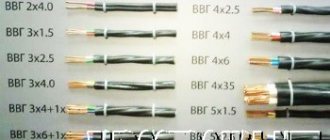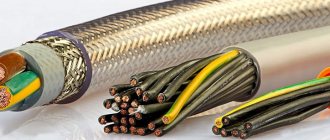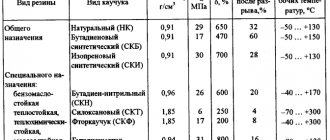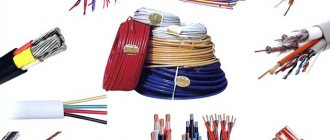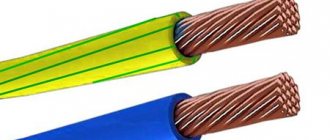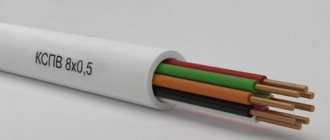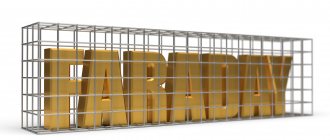Cable marking - applying color markings, symbols (inscriptions), tags and labels, as well as special electronic markers to the cable. The marking informs about the properties of a given cable, allows you to clearly identify it among other cables or locate its location.
A cable is a structure of one or more conductors (cores) insulated from each other, or optical fibers enclosed in a sheath. In addition to cores and insulation, a cable may contain a screen, core, filler, steel or wire armor, metal sheath, and outer sheath.
Wire - one uninsulated or one or more insulated conductors, on top of which, depending on the installation and operating conditions, there may be a non-metallic sheath, winding or braiding made of fibrous materials or wire.
Brands and scope
| Cable brand | GOST, TU | Application area |
| KG-HL KG-T KGN KPG KPGS KPGSN | TU 16.K73.05-93 | For connecting mobile mechanisms to electrical networks for rated alternating voltage up to 660 V with a frequency of up to 400 Hz or direct voltage up to 1000 V |
| KOG-1 | TU 16.K73.03-88 | For connection during arc welding of electric holders of welding installations with a rated voltage of 220 V AC with a frequency of 50 Hz or DC |
| KGE | TU 16.K73.02-89 | For connecting excavators and other mobile machinery to electrical networks with a rated voltage of 6 kV AC with a frequency of 50 Hz. |
| KShVGT-10 | TU 16-705.101-79 | For stationary and mobile installation and connection of mobile mechanisms to electrical networks with a rated voltage of 10 kV AC with a frequency of 50 Hz |
Tags used for inscriptions
Cable marking tags are used for marking control and power wires. They are made from polypropylene.
If there are hidden cable runs in walls or pipes, marking tags are fixed at the cable outlet and inlet, in the wells and chambers of the block sewer system and at the junction box. In the case of cable installation, marking tags are installed at each box or coupling, as well as at the end. In order to install the cable in damp areas, tags are made of plastic.
– cable marking U-134;
– cable marking U-153;
– cable marking U-135;
– cable marking U-136.
Designs and operating conditions
| Cable brand | Design | terms of Use |
| Basic (with copper stranded conductors with rubber insulation in a rubber sheath) | For bends with a radius of at least 8 cable diameters, at ambient temperatures from -40 to +50°C when exposed to solar radiation | |
| KG-HL | Using cold climate tires | The same, at ambient temperatures from -60 to +50°C |
| KG-T | With tinned copper wires and rubber for tropical climates | The same, at ambient temperatures from -10 to +55°C, with resistance to mold fungi |
| KGN | In an oil-resistant, flame-retardant shell | When bending with a radius of at least 8 cable diameters, with the possibility of oil getting on the sheath, at an ambient temperature from -30 to +50°C |
| CNG | With highly flexible cores | For bends with a radius of at least 5 cable diameters, at ambient temperatures from -50 to +50°C when exposed to solar radiation |
| CPGS | With highly flexible cores and profiled core | The same, if the cable can be exposed to shock and crushing loads |
Inscription on the product BPI
BPI cable marking according to GOST 18410-73 (paper cable impregnated with insulation):
- “A” – aluminum core.
- “B” - the armor is represented by thin steel strips.
- "AB" - aluminum armor.
- "SB" - lead armor.
- “C” – lead – shell material.
- “O” – a separate lead vein.
- “P” - armor is made of galvanized steel flat wires.
- “K” - armor is made of galvanized steel round wires.
- “B” is paper insulation that has depleted impregnation.
- “b” – no pillow.
- “l” – there is a pillow, and it includes a Mylar ribbon.
- “2l” – double tape included.
- “G” – no protective cover.
- “n” – the outer cover is non-flammable. Placed after the reservation.
- “Shv” - the cover is represented by a pressed hose consisting of polyvinyl chloride.
- “Shp” - the cover is represented by a pressed hose consisting of polyethylene.
- "Shvpg" - polyvinyl chloride has reduced flammability.
- “ozh” – single-wire conductors. Placed at the end.
- “U” – paper insulation, which has an increased heating temperature.
- “C” is paper insulation that is impregnated with a non-draining compound.
Number of cores in cables
| Cable brand | Number of cores | Nominal cross section | ||
| main | grounding | auxiliary | main cores, mm2 | |
| , KG-T, KG-HL, KGN | 1 | — | — | 2,5 — 120 |
| 2 and 3 | — | — | 0,75 — 120 | |
| 2 and 3 | 1 | — | 0,75 — 120 | |
| 2 and 3 | — | 1 | 2,5 — 70 | |
| 2 and 3 | — | 2 | 2,5 — 70 | |
| 4 and 5 | — | — | 1,0 — 25 | |
| CNG | 2 | — | — | 0,75 — 70 |
| 2 and 3 | 1 | — | 0,75 — 70 | |
| KPGS, KPGSN | 3 | 1 | — | 2,5 — 120 |
| 3 | 1 | 1 | 2,5 — 6,0 | |
| 3 | 1 | 2 | 4,0 — 50 | |
| KOG-1 | 1 | — | — | 16 — 150 |
| KGE | 3 | 1 | — | 10 — 150 |
| 3 | 1 | 1 | 10 — 150 | |
| KShVGT-10 | 3 | 3 | — | 25 — 150 |
What are wire insignia
All about cable installation
The symbols on the insulating coating are special marks applied by the manufacturer that indicate the various characteristics of cable products. These symbols characterize the class of the conductive element (copper, aluminum or other material), protection classes, outer covering layer, fire protection and other characteristics. Cable decoding is required upon purchase. When installed outdoors, on the ground or under water, an appropriate level of protection is required. Otherwise, accelerated damage to the wires and subsequent failure of the device is possible.
Core cross-section, mm2
| Main veins | Grounding conductors | Grounding conductors for KSHVGT-10 | Auxiliary cores |
| 0,75 | 0,75 | — | — |
| 1,0 | 1,0 | — | — |
| 1,5 | 1,0 | — | 1,5 |
| 2,5 | 1,5 | — | 1,5 |
| 4,0 | 2,5 | — | 2,5 |
| 6,0 | 4,0 | — | 4,0 |
| 10 | 6,0 | — | 6,0 |
| 16 | 6,0 | — | 6,0 |
| 25 | 10 | 6,0 | 10; 6.0 for KGE |
| 35 | 10 | 6,0 | 10; 6.0 for KGE |
| 50 | 16 | 10 | 10 |
| 70 | 25, 16 for KGE | 10 | 10 |
| 95 | 35, 25 for KGE | 16 | 10 for KGE |
| 120 | 35 | 16 | 10 for KGE |
| 150 | 50 | 25 | 10 for KGE |
The nominal insulation thickness and sheath thickness values for cables of brands , KG-HL, KG-T, KGN, KPG, KPGS, KPGSN are indicated in the table (in this case, large values of sheath thickness refer to cables with a large number of cores). Cable cores of brands , KG-HL, KG-T, KGN, KPG, KPGS, KPGSN must have digital markings or distinctive colors, while green-yellow insulation color is used only for the grounding core. The color of insulation for cables of the KOG-1 and KGE brands is not standardized; in cables of the KShVGT-10 brand, the main cores can have any color except black.
Insulated conductors must be twisted in the right direction, and to ensure operation under given conditions, insulated conductors in cables of the , KGN brands with three main and two auxiliary conductors with a cross-section of 16 mm2 or more, cables of the CPG brand with four conductors of 16 mm2 or more must be twisted around the rubber core, and in cables of the KPGS and KPGSN brands with four cores with a cross-section of 16 mm2 or more, five- and six-core all sections must be twisted around a round or profiled rubber core. In cables of the KShVGT-10 brand, all insulated cores must be twisted with a core made of electrically conductive rubber in the center, and the shell is made of two layers with an inner layer of electrically conductive rubber.
To make cable cutting easier, a layer of synthetic film or other material should be placed over the twisted cores. In cables of the KOG-1 brand and single-core cables of the brand, it is allowed to replace the insulation and sheath with an insulating protective sheath. The nominal thickness of the sheath must be equal to the sum of the thicknesses of the insulation and sheath.
Reference values of outer diameters and weights of cables of the most widely produced standard sizes are indicated in the tables. Taking into account significant tolerances, actual values may differ by 10% down or up.
Types of conductors
Electrical installation work involves the use of several types of conductive products.
Wires
They can be described as several wires connected by twisting. Both the presence and absence of an insulating layer are allowed. Wires are characterized by a light core sheath; it is rarely metal, although wires wrapped in wire are sometimes found.
They are popular for electrical work, for example, when wiring houses made of wood. The winding of an electric motor is made from wires.
Core material:
- Copper products are able to withstand significant current loads, these products are elastic and therefore break much less. But copper oxidizes quickly when used outdoors and is expensive for customers.
- Aluminum is not as durable as copper, but it is an order of magnitude cheaper than the copper option.
When choosing a material, it is worth remembering that wires with different core materials cannot be connected to each other by twisting; for this you will have to use terminals. This is due to copper's ability to oxidize. As a result of this improper installation, the wires will begin to move away from each other, causing increasingly frequent power outages.
Contacts:
- Isolated. They can be with or without protection. The latter option involves additional insulation for the cores. The protection is made of plastic or rubber.
- Naked. We will try this option in the installation of power transmission.
Purpose:
- Installation wires are used to connect parts of electrical circuits. They are made of copper.
- Power wires are used indoors for electrical wiring.
- Installation.
Cable
Roughly speaking, a cable is a number of wires connected by twisting. All of them are located inside a common insulation. It is made from various materials, including rubber, PVC, and plastic. In addition to it, there is often another layer of shell for protection. It is made of metal in different forms: tape or wire.
Cable types:
- Communication cable . Thanks to currents that differ from each other in frequency, it transmits encrypted information. On local communication lines, transmission is carried out using low-frequency conductors, and for long-distance lines, high-frequency conductors are used.
- Controls . They are necessary for the functioning of electrical devices. With the help of this product, the control signal is transmitted from a person to a mechanism.
- Radio frequency . Indispensable for transmitting radio signals and video signals. Present in all radio devices.
- Management _ Consists of a conductor made of copper and a protective shield. It is necessary to protect against mechanical damage or to remove interference. Found application in automatic systems.
- Power cables transmit energy in a variety of devices that require high voltage. They are used to conduct electricity overhead or underground (external wiring). They also carry out internal wiring in rooms. Inside this product there are copper or aluminum conductors. Preference is given to the first option. The insulating layer is paper, rubber, PVC, polyethylene, and so on.
Cord
This product consists of two or more conductors of small cross-section. They must have elasticity. Each core consists of a large number of intertwining wires. Any winding other than metal is used as an insulating layer. These products rarely have two wires, because in this case they are used when the device does not require mandatory grounding. Cords are necessary to connect various electrical appliances to the network.
The main differences between conductors:
- Number of cores: single-core or multi-core products;
- Cross-section of conductor cores;
- Voltage;
- The protective shell and the material from which it is made;
- Insulation, material;
- The metal used for the manufacture of cores: copper, aluminum or a composite made of two metals - aluminum-copper.
Insulation and sheath thicknesses for cables of brands KG, KG-HL, KG-T, KGN, KPG, KPGS, KPGSN, mm
| Nominal cross-section of main cores, mm2 | Insulation | Sheath for single-core cables | Sheath for multi-core cables |
| 0,75 | 0,8 | — | 1,3 — 1,5 |
| 1,0 | 0,8 | — | 1,3 — 1,6 |
| 1,5 | 0,8 | — | 1,5 — 1,8 |
| 2,5 | 0,9 | 1,4 | 1,7 — 2,0 |
| 4,0 | 1,0 | 1,5 | 1,8 — 2,2 |
| 6,0 | 1,0 | 1,6 | 2,0 — 2,5 |
| 10 | 1,2 | 1,8 | 3,1 — 3,6 |
| 16 | 1,2 | 1.9 | 3,3 — 3,9 |
| 25 | 1,4 | 2,0 | 3,6 — 4,4 |
| 35 | 1.4 | 2,2 | 3,6 — 4,5 |
| 50 | 1,6 | 2,4 | 4,5 — 5,0 |
| 70 | 1,6 | 2,6 | 4,8 — 5,0 |
| 95 | 1,8 | 2,8 | 5,0 — 5,3 |
| 120 | 1,8 | 3,0 | 5,0 — 5,3 |
Flexibility classes
The following categories of cable flexibility are distinguished:
- There are from 1 to 59 wires inside, and their cross-section ranges from 0.03 to 1000 square meters. mm.
- The diameter is 0.5-2000 square meters. mm. Quantity - approximately 7-91.
- The diameter of the veins ranges from 0.33 to 0.87 square meters. mm.
- Diameter - 0.06-400 sq. mm.
- The diameter can be 0.03-625 square meters. mm.
- The cable is considered the most flexible. Diameter - 0.06-0.4 sq. mm.
Conventionally, the first category is nominal, the second to fourth are elevated, and the last two are high.
Colors of cores for cables of brands KG, KG-HL, KG-T, KGN, KPG, KPGS, KPGSN
| Number of cores | Color without grounding conductor | Coloring with grounding conductor |
| 3 | blue, black, brown | green-yellow, blue, brown |
| 4 | blue, black, brown, black or brown | green-yellow, blue, black, brown |
| 5 | blue, black, brown, black or brown, black or brown | green-yellow, blue, black, brown, black or brown |
| 6 | — | green-yellow, black, blue, black, brown, black |
Deciphering the markings
Deciphering the characteristics of a wire or cable begins with the symbolic marking applied by the manufacturer to the insulation - it usually contains comprehensive information about the materials from which the conductor is made and other parameters. The order of symbols and their meanings are established by GOST, with the exception of situations when conductors are made
So, the first letter in the marking of any cable indicates the metal of the cores, but it is not always placed. The fact is that only aluminum wires are marked with a capital letter “A”. And if there are copper conductors, no marking is applied.
The second (in copper wires - the first) letter in the marking allows you to find out the purpose of the cable. The following codes are used here:
- P – flat;
- M – installation;
- Ш or П(У) – installation;
- MG – installation cable with flexible cores;
- K – control.
The third letter in the marking of electrical conductors serves to designate the insulating material of the conductors. Their variety is quite large:
- V/VR – polyvinyl chloride shell;
- R – rubber is used to insulate the cores;
- N/NR – fire-resistant rubber or nayrite;
- K – nylon shell;
- L – varnished insulation;
- P – polyethylene;
- F – fold;
- E – enamel;
- Ш – polyamide type silk;
- O – polyamide silk insulation is braided;
- E – shielded insulation;
- G – insulating shell with flexible conductors;
- C – fiberglass;
- T – the insulation design includes a support cable.
The marking of a rubber insulated cable, which has additional protection made of nayrite or PVC, is done as follows: first indicate the above symbols, and then the marking of the cores.
The decoding of the following symbol makes it clear what design features this cable has. According to the current GOST, these are the following letters:
- A – asphalted cable;
- B – cable with armor tapes;
- G – flexible wire without protection;
- K – cable armored with round wire;
- T – wire intended for laying in pipes;
- A – the cable has additional braided protection.
The abbreviation frls at the end of the cable marking refers to the degree of compliance with fire safety requirements. FRLS is formed from two abbreviations that describe the characteristics of conductor materials: FR - fire resistance, LS - low smoke emission. Thanks to this, the frls cable does not support combustion even when laid in a group, and even remains operational for some time in fire conditions (this is important, for example, for the operation of a fire protection system). Most often, the frls version uses cables VVGng-FRLS (power), KPSEng(A)-FRLS, KSBNG(A)-FRLS (cables for fire protection systems).
Insulation and sheath thicknesses for KOG-1 cables, mm
| Nominal cross-section of main cores, mm2 | Internal and external screens for core and insulation | Insulation | Belt screen | Shell |
| 10 — 50 | 0,4 | 4,0 | 1,5 | 3,5 |
| 70 — 150 | 0,6 | 4,0 | 2,0 | 4,0 |
Decoding a special abbreviation
Marking of wires and cables that have a specialized abbreviation:
- KSPV cables are designed for special sheathed transmission systems.
- KPSVV – cables are intended for fire alarms.
- KPSVEV - cables are designed for fire alarms, only they include a screen.
- PNSV – heating wire with a steel core.
- PV-1, PV-3 – vinyl insulated wire. Core flexibility – 1.3 class.
- PVA is a wire with a vinyl sheath (connecting).
- SHVVP – vinyl insulated cord (flat).
- PUNP – flat universal wire.
- PUGNP – flexible flat universal wire.
Thicknesses of structural elements for cables of the KShVGT-10 brand, mm
| Nominal cross-section of main cores, mm2 | Internal screen along the core | Insulation | External insulation screen | Inner shell | Outer shell |
| 25 — 70 | 0,8 | 6,0 | 1,0 | 3,0 | 5,0 |
| 95 — 150 | 1,2 | 6,0 | 1,0 | 3,0 | 6,0 |
Electrical Requirements
For the period of acceptance and delivery, cables of brands , KG-HL, KG-T, KGN, KPG, KPGS, KPGSN must withstand an alternating voltage test for 5 minutes without immersion in water, and single-core and cables of the KOG-1 brand after being in water are subject to an alternating voltage test 2 .5 kV with a frequency of 50 Hz. Cables of the KGE brand must withstand a voltage test of 15 kV, and cables of the KShVGT-10 brand - 20 kV alternating current with a frequency of 50 Hz for 5 minutes.
The electrical insulation resistance under normal climatic conditions, recalculated per 1 km of cable, upon acceptance and delivery must be at least 50 MΩ, for cables of the KShVGT-10 brand, at least 100 MΩ.
Advice
So, as can be seen from the article, the marking of wires and cables (GOST, by the way, is what the consumer should first pay attention to when purchasing) is very diverse. And it will not be easy for an ordinary person to deal with this. Therefore, we will give advice: to work with cables and wires, seek the help of specialists. It will be good if the services of this master include not only the necessary work, but also the purchase of the necessary material so that you do not get confused. If you decide to independently carry out any work related to cables and wires, then we should wish you good luck in this difficult task!
Outer diameters of cables, mm
| Nominal cross-section of main cores, mm2 | Single-core brands, KG-HL, KG-T | With three main conductors and a grounding conductor of brands KG-HL, KG-T, KGN | With three main conductors and a grounding conductor of the CNG brand | With three main conductors and a grounding conductor of brands KPGS, KPGSN | KOG-1 | KGE | KShVGT-10 |
| 0,75 | — | 10 | 10 | — | — | — | — |
| 1,0 | — | 10 | 10 | — | — | — | — |
| 1,5 | — | 11 | 11 | — | — | — | — |
| 2,5 | 7,0 | 13 | 13 | 16 | — | — | — |
| 4,0 | 8,0 | 16 | 16 | 18 | — | — | — |
| 6,0 | 9,0 | 18 | 19 | 22 | — | — | — |
| 10 | 10 | 23 | 24 | 25 | — | 41 | — |
| 16 | 13 | 25 | 28 | 30 | 10 | 44 | — |
| 25 | 15 | 30 | 32 | 34 | 12 | 46 | 67 |
| 35 | 17 | 35 | 38 | 38 | 14 | 50 | 72 |
| 50 | 19 | 42 | 44 | 45 | 16 | 54 | 74 |
| 70 | 22 | 45 | 49 | 49 | 18 | 63 | 79 |
| 95 | 24 | 51 | — | 53 | 20 | 67 | 86 |
| 120 | 27 | 56 | — | 58 | 23 | 72 | 91 |
| 150 | — | — | — | — | 25 | 78 | 97 |
